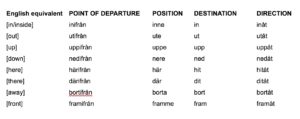I am not a poet, and I will never be. But I am fascinated with language, and partly because of its reflection of culture and social practice. Somehow, our language enables us to think, and learning a new language always give your insight into a new way of thinking.
In my opinion, the greatest potential of the Swedish language lies in its ability ot distinguish between the static and change, between positions, destinations, and points of departure. I love the difference between är and blir, har and får. Whereas är and har are static, permanent, stable, unchanging, blir and får is that journey to get there. When I was living in the UK, I shocked my friends when I told them another friend of mine was about to get a child. This mis-use of terms (I learnt later that people have children, also in the process of acquiring them) comes straight from the Swedish får. First you have no children (Jag har inte barn), then you give birth (Jag får barn), and the result is that you have them, on a permanent basis (Jag har barn).
Spatial relations
Consider the difference between hemifrån, hemma, and hem. All words would roughly translate as [home]. Starting with hemifrån, that is a point of departure, let us consider the following examples: går hemifrån [leaving home], flyttar hemifrån [moving out from your parents’ place], arbetar hemifrån [working from home]. Hemifrån is not the main focus in these sentences, but a place you have already left, with another location in mind.
In contrast, hemma is as stable as anything can get, a fixed position. Jag är hemma [I am at home], Borta bra men hemma bäst [home sweet home]. Hem, however, is a destination. Jag går hem nu [I am going home now], vi är på väg hem [we are on our way home], Kom hem! [Come home].
Hemåt, similar but not identical, is a direction. Jag går hemåt [I am going in the direction of my place], suggests that there will be stopovers, improvisation, that this is not a straight path, compared to jag går hem.
Similarly, most adverbs relating to space employ this system.

My favourite here is the last one.
This is, unfortunately very confusing for my students, and I am often very scared when introducing them to this system. Whereas the other adverbs make sense, somehow, fram can be very tricky to conceptualise.
Framifrån – from the front. Passfotot måste tas framifrån, inte i profile [You passport picture is taken from your front, not your profile].
Framme – the position that comes at the very ‘front’ of a long journey. Ring mig när du är framme [Please call me when you are there]. När är vi framme? [When will we be there], the kids are asking from the backseat.
Fram – Nu har vi kommit fram [We have now reached our destination]. Ring mig när du kommer fram [Please call me when you get there]. But also, Han sitter längst fram i tåget [He is sitting at the very front of the train], hon står längst fram i kön [She is at the very front of the queue].
The distinction between Ring mig när du är framme and Ring mig när du kommer fram is very subtle. Firstly, you need to understand the relationship between the adverb (framme/fram) and the verb. A ‘static’ verb like är needs to come together with a position (framme), whereas a verb implying there is a movement (A –> B) comes together with a destination (fram). The first one (framme) implies a higher degree of settling, perhaps having unpacked, or sat down in a hotel bed, whereas the second one (fram) would refer to that final moment of your journey, landing after a flight, putting the key in a new door.
Framåt – a direction, like [forward]. My children, playing with their toy cars, say bilen åker framåt, bilen åker bakåt, bilen åker framåt, … as the car is moving forward and backward and forward. Det går framåt [Things are going forward].

